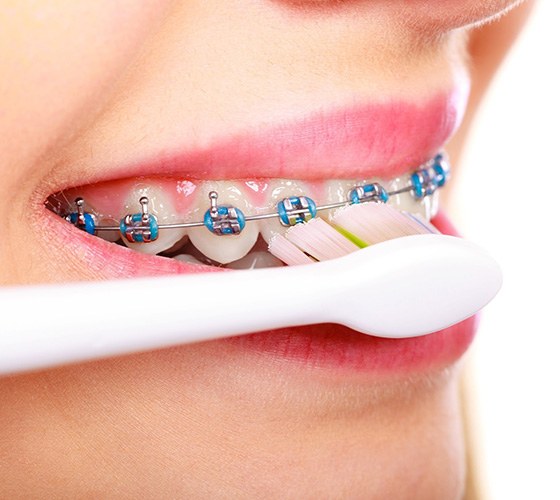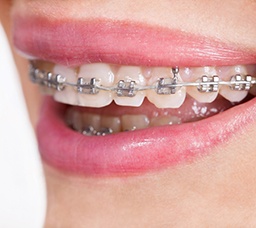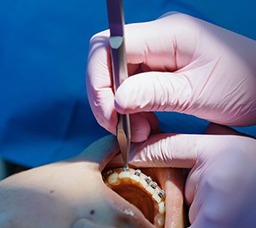Traditional Braces – Western Massachusetts
Invest in a Straight, Confident Smile
Straight teeth contribute to better oral health, create stronger bites, and lead to a stronger sense of self-esteem. If you or your loved one is ready to take the plunge with braces in Western Massachusetts to finally correct those frustrating gaps and misalignments, you’ve certainly come to the right place. At Treehouse Orthodontics, we only use the highest quality brackets and wires, and no materials are EVER recycled from case to case. To schedule a one-on-one consultation, please contact one of our eight orthodontic office locations, including Northampton, Amherst, and West Springfield.
Why Choose Treehouse Orthodontics for Traditional Braces?
- Treat Patients of All Ages
- Over 50 Years of Experience
- Affordable Payment Options
How Do Traditional Braces Work?

Traditional braces have been around for many years, and their effectiveness when it comes to correcting even the most severe orthodontic concerns is unquestioned. Children and adults alike are great candidates for this reliable treatment plan.
Construction-wise, braces have three distinct components. First, there are the brackets, which are directly bonded onto the surface of teeth. Each bracket will have unique characteristics, depending on its position and the goals our orthodontists hope to accomplish with its placement. Once the foundation is in place, it’s time to add the catalyst – the archwire. Your orthodontic wire is attached to the brackets while bent. As it returns to its original shape, it will apply a consistent amount of pressure to the teeth and shift them towards their desired alignment. Finally, elastics will connect the brackets and archwire(s), and they come in a variety of fun and neutral colors that our patients can choose from.
What Orthodontic Issues Can Braces Fix?

Braces can treat the most complete bite and alignment issues, including:
Bite Misalignment
Braces can create a balance between the upper and lower teeth to improve oral functions and health.
Crowded & Crooked Teeth
The system of brackets and wires can straighten teeth to make them easier to keep clean, lowering your risk of cavities, gum disease, and other issues.
Gapped Teeth
Braces can close gaps between teeth to create a straight smile to lessen your risk of preventable dental issues.
Caring for Your Braces

Good oral hygiene is more important than ever when undergoing orthodontic treatment. Brush and floss your teeth in the morning, at night, and after every meal. Pay careful attention when cleaning around your brackets. Your orthodontist will review dietary restrictions to prevent damaging your enamel, like popcorn, nuts, and candy. Besides caring for your braces at home, maintain your appointments for adjustments. Don’t forget to schedule your semi-annual cleanings and checkups.
It’s never too late to invest in a straight smile. Request an appointment through our website or contact our office.
Understanding the Cost of Traditional Braces

It is common for patients to ask about the cost of traditional braces. This smile-improving solution requires much time and patience, so it’s important that your investment is worth it. At Treehouse Orthodontics, we will go over the expenses that are required to receive braces, as well as discuss the various ways you can pay for treatment and stay within your budget.
Factors That Affect the Cost of Traditional Braces

There is no one-size-fits-all treatment when it comes to wearing braces. Instead, your plan will be fully customized based on your needs. This means that what you pay will likely be different than what someone else might pay.
Some of the factors that can affect the cost of your orthodontic treatment include:
- The type of orthodontic issues you are experiencing. This can include overcrowding, spaced (gapped) teeth, or a misaligned bite.
- Your age
- How well you follow treatment instructions provided by our team
- Whether you require additional orthodontic appliances to help your teeth continue to move (i.e., space maintainer, elastics, etc.)
Professional Braces vs. "DIY" Braces: Which Costs More?

It’s no surprise that DIY braces are becoming increasingly popular, especially among social media influencers and their followers. Unfortunately, attempting to straighten your teeth on your own puts you at risk of further damaging your teeth and smile.
First, an orthodontist must determine if you are suitable for braces. If so, the brackets and archwire must be placed correctly to avoid any potential complications.
Seeing an orthodontist for professional treatment is the safest, most effective way to ensure your teeth move in the right direction over time.
Does Dental Insurance Cover Braces?

Dental insurance companies may offer some form of coverage for orthodontic treatment; however, this is not a certainty. Reviewing your policy is essential if you want to avoid paying high out-of-pocket costs. While most plans will provide up to 50% coverage for treatment, you will be required to pay the remaining portion.
Other Options for Making Braces Affordable

If you need help to pay your out-of-pocket costs, Treehouse Orthodontics will be happy to discuss two additional options to make your braces more affordable.
We currently offer in-house dental financing that allows you to break up your bill into manageable installments based on the plan you choose and with little-to-no interest.
We also partner with Cherry Financing so that you can choose to enroll in one of their available plans and save over time. With no hidden fees and 0% APR options that are available for up to 24 months, you can save more as you work toward a straighter, healthier set of teeth.
Traditional Orthodontic FAQs

Traditional orthodontics can fix a variety of bite and alignment problems; however, braces are a big investment. Don't worry if you have any concerns because your orthodontist will explain everything during your consultation. You can also contact our office or take a look at the most frequently asked questions below.
Am I Too Old to Get Braces?
You're never too old to invest in a straight, healthy smile. 1 in 5 orthodontic patients is over the age of 18. Age is just a number when it comes to your candidacy or braces. Your orthodontist will examine your mouth to look for anything concerning that must be addressed first, like cavities or gum disease. Although it may add a couple more steps to your treatment plan, you'll have a straight smile in no time.
How Long Do Traditional Braces Take?
The average treatment with metal braces is about 18 to 24 months, but many factors affect the duration. Age can play a role in your treatment’s timeline because adult teeth are firmly set in the jawbone, so it can take longer for them to move. The complexity of the tooth movements needed can also influence how long you'll need to wear braces. You can ensure there aren't any delays in the process by following your orthodontist’s instructions and maintaining your appointments for adjustments.
Are Traditional Braces Cheaper Than Invisalign?
Believe it or not, traditional braces and Invisalign can cost about the same, depending on your situation. Your orthodontist can give you an estimate for both options, and you may be able to use your dental insurance. If your policy includes orthodontic coverage, your insurance will pay a set amount after meeting your annual deductible. We will work on your behalf with your dental insurance to maximize your benefits to lower the amount you will pay out-of-pocket. We also offer various financial solutions to keep a straight smile affordable for everyone.
What Happens When Braces Come Off?
When it's time for your braces to come off, your orthodontic journey isn't over just yet. You'll need to wear a retainer to prevent your teeth from moving back into their previous positions. Initially, you may need to wear it all the time. As your teeth begin to set in their new positions, you'll need to wear it less often, until it's only needed at night. Retainers come in many discreet options, so you don't have to worry about it affecting your professional image.
Can Braces Fix TMJ Dysfunction?
Braces can be a great option to treat TMJ disorders caused by a poor bite. They will move your teeth to improve the relationship between your upper and lower arches to take pressure off your temporomandibular joints. You can enjoy a permanent fix to resolve your TMJ dysfunction; however, every case differs.
How Do I Take Care of My Braces?
Your oral hygiene is important when wearing braces. Food particles and plaque can build up around your brackets and wires, increasing your risk of tooth decay, stains, and gum disease. Besides brushing your teeth twice a day, brush and floss after every meal. Angle your toothbrush when cleaning your teeth to remove buildup around your brackets. A dental threader will allow you to easily pass the floss between your teeth. However, some patients find an oral irrigator easier to use. A jet of water is used to clean hard-to-reach areas, like between your teeth. Besides brushing and flossing, don't forget to maintain your semi-annual dental cleanings and checkups.
Do Braces Hurt?
It's normal for your mouth to be tender after getting your braces, but it's a sign your treatment is working. The system of brackets and wires applies continual pressure to move your teeth in small increments, which can make your mouth sore. Discomfort can also occur when having adjustments made to your arch wire. As you progress through your treatment, tenderness will become less frequent. You can manage your discomfort with an over-the-counter pain reliever and eating soft foods. Take an anti-inflammatory before your adjustment appointments to stay ahead of any tenderness. If your brackets or wires are irritating the insides of your lips and cheeks, apply dental wax to reduce friction and irritation.
Can I Chew Gum with Traditional Metal Braces?
Researchers have found several benefits of chewing gum after eating, like a decreased risk of cavities. However, if you tend to chew gum to keep your breath fresh and your mouth clean, you're going to have to give up the habit while wearing braces. Gum can get stuck in your brackets and wires, which can be almost impossible to remove.
Can I Get Braces on Just the Top Teeth?
Single-arch treatment with braces is possible, but it is rare. Your upper and lower teeth must rest together harmoniously. Moving teeth in just one arch can throw off the balance, causing bite problems, jaw pain, and even dental issues. Your dentist will likely recommend braces on both the top and bottom teeth. However, if you only need a minor adjustment, like closing a gap between front teeth, you may be a candidate for single-arch treatment.
Invisalign Clear Aligners Orthodontic Emergencies View Our Services
